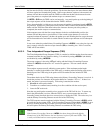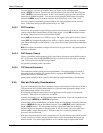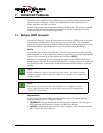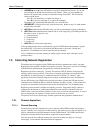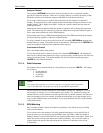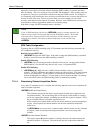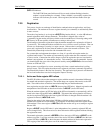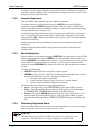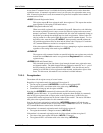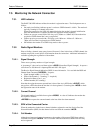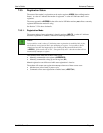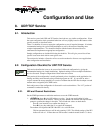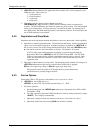
User’s Guide Advanced Features
2110212 Rev 1.0 Page 57
OPR LED Indicator
The DART 300 front panel indicator will be on steady (without flashing) when the
modem is on and scanning for a channel. When a channel is successfully acquired, the
indicator will flash once per second. When registered, the indicator flashes twice per
second.
7.2.2. Registration
This process involves an exchange of identification, authentication, encryption keys, and sleep
characteristics. The modem can be set to register manually (on command), or automatically when
it starts or resets.
The mode of registration is set in register +WS173 (Registration Mode). A value of 0 indicates
manual registration and 1 indicates automatic. The modem is shipped with a value of
1 (automatic) but the modem will always default to the last method used. Restoring settings with
&F (factory) or Z (user profile) will not restore a setting to this register.
The advantage of automatic registration is that the modem attempts to be registered at all times it
is powered on. This makes the modem available for use as a client or server at all times. That can
be seen as a disadvantage if security is a major concern. If the modem is configured to act as a
server and is registered at all times, then the modem is open to the network at all times. The
Friends Only feature helps reduce the risk of unauthorized access.
For systems that can implement the modem as a client, it is possible to keep the modem de-
registered until needed. The modem will automatically register when the dial command is issued
to start a session. Connection time will be longer to allow the registration process, but when the
modem is not registered, it is unreachable (secure). This technique is not recommended. Instead,
you should disable the server side of the protocol stack by setting +WS212=0 as discussed in the
sections on UDP and TCP.
Most systems are configured as servers, answering calls from a central monitor that is polling
devices in turn. This will require the modem to be registered at all times (automatic registration).
The Friends Only feature is the first line of security. The application layer protocol used between
the local and remote hosts can also be designed to improve security.
7.2.2.1. Active and Auto-register NEI Indices
The NEI (IP address) the modem attempts to register with the network is determined differently
for manual and automatic registration. The modem keeps two separate index entries to the NEI
table. These indices have an intricate inter-relationship that you should understand.
Auto-registration uses the index at +WS176 (Auto-register NEI Index). Manual registration and
manipulation of the NEI table are based on an index at +WS197 (Active NEI Index).
When the modem registers an NEI, the index of the NEI used (manually or automatically) will be
stored in the Auto-register NEI Index (+WS176). This means that auto-registration will always
use the last registered NEI unless the Auto-register NEI Index is changed while the modem is de-
registered in manual (+WS173=0) mode.
Changing the setting in the Auto-register NEI Index while the modem is registered causes the
modem to de-register the old NEI address. This happens in both manual and auto-register modes.
If the modem is set to auto-register (+WS173=1) then the modem will go on to attempt to register
the new NEI.
Register +WS197 (Active NEI Index) is quite independent of any currently registered NEI and
can be changed freely. This allows access to other table entries while registered without affecting
the registration status.
The manual registration command (+WPREG) will use the Active NEI Index (+WS197) as the
address to register. It will also store the value of the Active NEI Index (+WS197) into the Auto-
register NEI Index (+WS176) so that it becomes the default address for future auto-registration.
This copying of the index takes place even if the manual registration fails.



